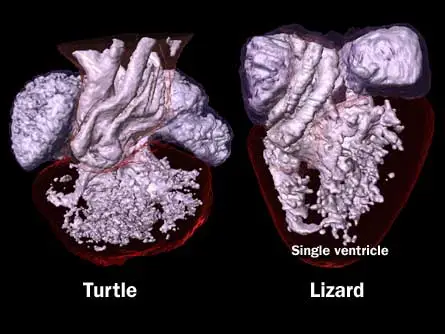From three to four chambers
Scientists identify gene that may shape the heart
- More than 2 years ago
Lizards and turtles are not warm and cuddly, but they do have hearts — and interesting ones, at that. One molecular difference in reptile hearts may have divided single ventricles into two, creating four-chambered hearts from three-chambered ones as species evolved, a study published in the Sept. 3 Nature finds.


“The major question has been, what drove the evolution of the four-chambered heart?” comments James Hicks, an evolutionary biologist at the University of California, Irvine. Results from the new study “could lead to a deeper understanding of the fundamental factors involved in heart development,” he says.
Amphibians have three-chambered hearts made up of two top chambers, atria, and one bottom chamber, the ventricle. Mammals and birds have two atria and two ventricles, with ventricles separated by a muscular ridge called a septum.
Reptile hearts, on the other hand, have long been a mystery, says study coauthor Benoit Bruneau of the Gladstone Institute of Cardiovascular Disease in San Francisco. Lizard and turtle hearts appear to be intermediate forms, with two atria and a semiseparated ventricle, Bruneau says. Muscular ridges lie in the middle of the ventricular region, but the anatomy didn’t reveal whether they were true septa or not. With the new study, “We wanted to lay that uncertainty to rest,” Bruneau says.
Researchers already knew that in mammals and birds, a gene called TBX5 was active during development on the left side of the heart where the left ventricle forms, but not on the right side.
Bruneau and his colleagues looked for TBX5 gene activity in the developing hearts of red-eared slider turtles and green anole lizards to see if the segregated pattern of TBX5 was present in reptiles. Early in development, TBX5 was active throughout the entire ventricle region in both turtle and lizard hearts. But later in development, TBX5 activity had disappeared from the right side of the turtle heart, remaining only in the left side. Such separation suggested that the turtle does indeed have two ventricles, Bruneau says. In the lizard heart, TBX5 had no separation; the even spread of TBX5 suggested a single ventricle.
“We were able to conclusively say that the large structure found in lizards is not a septum,” Bruneau says. Lizards are thought to have evolved earlier than turtles, the authors write, suggesting that TBX5’s left-right segregation, and the ensuing ventricle separation, evolved later.
But just because the TBX5 pattern correlated with septum formation — or lack thereof — doesn’t mean that TBX5 was actually causing ventricle separation. “We didn’t know how important the TBX5 pattern was,” Bruneau says.
So the researchers manipulated the pattern of TBX5 in developing mice hearts. When researchers shifted levels of the gene’s expression, the mice hearts failed to form two ventricles. Likewise, when TBX5 was expressed everywhere throughout the ventricle region, similar to what happens in the lizard heart, the mice hearts failed to form two ventricles.
“We found that the activity of TBX5 is really important for septation,” Bruneau says. “I’ve always wondered about the evolution of the heart. Being able to pinpoint an important regulator of the heart is exciting.”
A four-chambered heart with two distinct ventricular chambers allows the heart to produce two different blood pressures: low pressure for blood pumped to the lungs and high pressure for the oxygen-rich blood pumped out to the rest of the body. This dual pressure system is a key requirement for an animal to be warm-blooded, Hicks says, which is “an important trick to have.” Animals that are warm-blooded may have higher growth rates, niche expansion and greater competitiveness in an environment, he says. “Now that the tools are there, we can now look at a whole variety of reptiles,” Hicks says.
Not only does the new study shed light on the evolution of the four-chambered heart, but it also may lead to a greater understanding of congenital heart diseases, some of which are known to be caused by TBX5 mutations. “A big reason we were interested in TBX5 is that it is related to human heart diseases,” Bruneau says.







